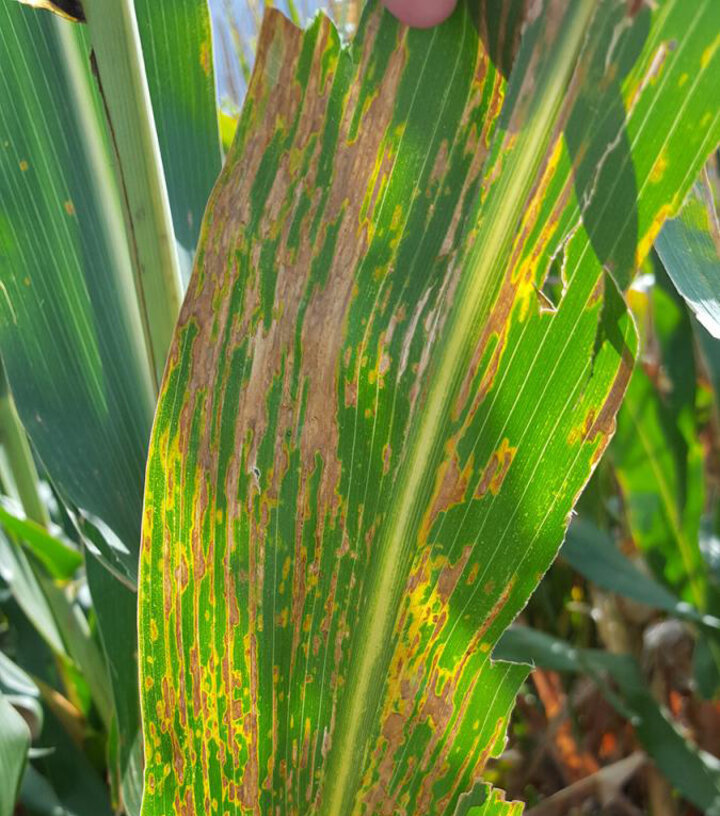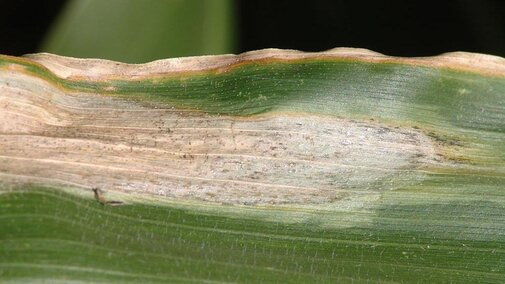Though relatively small, the Department of Plant Pathology at UNL has played a significant role in the discovery of many economically important plant diseases. Most recently, a new fungal pathogen causing Fusarium head blight of wheat was identified, joining a growing list.
Fusarim Head Blight of Wheat Caused by Fusarium boothii
In 2015, widespread epidemics of Fusarium head blight (FHB) occurred in wheat in Nebraska. During a wheat disease survey, symptomatic wheat heads were collected from the major wheat growing regions in the state. Three isolates, two from Chase County in the southwest and one from Box Butte County in the northern Panhandle, were identified as Fusarium boothii. The F. boothii isolates were inoculated onto wheat heads in the greenhouse and caused typical FHB symptoms. The remainder of the isolates were identified as F. graminearum which until now was the only known cause of FHB in the United States. F. boothii has been reported in Texas on corn and as the cause of FHB of wheat or Gibberella ear rot of corn in several countries including Mexico and South Africa. To date, F. boothii has not been confirmed on corn in Nebraska.
Sunflower Virus (unnamed)

First observed in 2010, a novel viral disease of sunflowers has been identified in Nebraska. It has not yet been named, but is a member of the family Tombusviridae, based on molecular and morphological characterizations. This soilborne virus was first noted in 2010 and again in 2011 and 2014 from commercial fields. It was found again in 2018 infecting volunteer sunflowers within a chickpea research field due to the cool rains early in the spring. It was also observed from dozens of early-planted ornamental sunflowers used as a border for other research plots.
Bacterial Leaf Streak of Corn

Beginning in 2014, an unknown bacterial disease was observed on corn in Nebraska. In 2016 it was identified as bacterial leaf streak (BLS) of corn, caused by Xanthomonas vasicola pv. vasculorum. It was unknown in the United States, but had been reported as a pathogen of corn in South Africa (and Brazil and Argentina in recent months). Since its discovery, the disease has been confirmed in 74 counties across much of Nebraska and also in Colorado, Illinois, Iowa, Kansas, Minnesota, Oklahoma, South Dakota, Texas, and Wisconsin. Due to the similarity of BLS symptoms to the fungal disease gray leaf spot (GLS), BLS is not easily distinguished from GLS and was likely misidentified prior to its discovery. This disease has also been shown to infect grassy weeds such as some foxtail species, shattercane, orchardgrass and more. Research is currently ongoing to further classify the impact of this pathogen on corn in Nebraska.
Goss’s Bacterial Leaf Streak of Corn

In 1969 David Wysong, Anne Vidaver, and Max Schuster discovered and characterized a new bacterial pathogen of corn (Clavibacter michiganensis subsp. nebraskensis) from central Nebraska near Lexington. Initially called Nebraska bacterial wilt and leaf freckles, this disease causes both a foliar blight and a systemic vascular wilt. Eventually, the settled name became Goss’ wilt and leaf blight. Susceptible hybrids could have a 50% yield loss. It was soon found throughout Nebraska, Iowa, South Dakota, Kansas, and Colorado before essentially disappearing in the early 1980s. In the mid 2000-2010 Goss’s wilt and blight reappeared in western Nebraska, southeastern Wyoming, and northeastern Colorado, occasionally causing severe infections. The disease was found throughout Nebraska in 2009 and has since been found across the Corn Belt from Texas into Canada.
A History of Plant Disease Firsts
In addition to these Nebraska plant disease "firsts," over the years UNL’s Department of Plant Pathology has had a series of plant disease discoveries and contributed to several milestones.
1884 - Although not officially recognized as a separate entity from botany until about 1920, plant pathology actually began in 1884-1885 with the arrival of Charles Bessey. He strongly promoted plant pathological studies and additionally included plant diseases in his botany course in 1884. Between 1885 and 1905 Bessey and his students produced almost a dozen reports, papers, and bulletins pertaining to plant diseases, the first plant pathology publications in Nebraska.
Late 1890s – George Hedgcock, a student of Bessey’s, reported observations on severe disease outbreaks occurring prior to 1888 on garden beets in Nebraska. Today the disease is assumed to be beet curly top virus, transmitted by leafhoppers.
1912-1914 – Seedling rust of sugar beet (Puccinia subnitens) was identified for the first time by Venus W. Pool (former UNL graduate student) in Colorado on sugar beets. Pool worked out its unique life cycle and several alternate hosts. In 2010, Robert Harveson reported a widespread epidemic of this same rare disease throughout the Nebraska Panhandle, making it the first documentation of the disease from a field infection in a century.
1922 – George Peltier generally is credited with the discovery and first recognition of wheat steak mosaic virus from UNL’s research plots in Lancaster County. He mechanically transmitted the pathogen to healthy wheat and corn plants using plant sap from symptomatic wheat plants.
Mid-1920s – The appearance of bacterial wilt of alfalfa, caused by Clavibacter michiganensis subsp. insidiosum, from Nebraska river valleys was noted by George Peltier simultaneously with similar reports from Kansas, Wisconsin, and Illinois. His work on this disease with the USDA’s H. M. Tysdal resulted in the winter-hardy, wilt-resistant cultivar, ‘Ranger’, which was the first alfalfa cultivar developed using a gene derived from a foreign source for disease resistance with corresponding desirable agronomic traits.
1949 – Max Schuster first identified the false root-knot nematode (Nacobbus aberrans) from sugar beets. This nematode was first observed near Mitchell, and later was found in uncultivated land in Scottsbluff and Sioux counties, suggesting it is native to western Nebraska.
1949 – Bacterial wilt of dry beans, caused by Curtobacterium flaccumfaciens pv. flaccumfaciens from Nebraska, was identified by Max Shuster. The original report from South Dakota described bacterial isolates that were yellow-pigmented. Schuster then identified another pathogen color variant (orange) in 1957 and in 1967 with Anne Vidaver, a purple color variant. Robert Harveson discovered a fourth color variant (pink) of the pathogen in 2008. All new color variants were found originally in Scotts Bluff County.
1954 – William Allington, along with entomologist Robert Staples and agronomist Charlie Fenster, studied the spread and degree of damage caused by the wheat streak mosaic pathogen. These studies established the epidemiology of the disease after a historically severe hail storm moved through Kimball and Cheyenne counties the previous year.
1966 – The vector (Polymyxa graminis) for wheat soilborne mosaic virus from Nebraska was identified by Myron Brakke.
1970s – Anne Vidaver and James Van Etten identified a bacteriophage (a virus that infects bacteria) that was able to infect Pseudomonas phaseolicola, the causal agent of Halo Blight in common bean.
1972 – Charlie Fenster (UNL Department of Agronomy), Mike Boosalis, and John Weihing conducted research for more than 20 years on the stress-related root and crown rot disease of wheat. The disease was found to be reduced by varying planting dates for different regions based on elevation of fields. This disease was a major production constraint for many years in western Nebraska, and recommendations are still being used today based on this concept.
1976-1979 – Bacterial Mosaic of Wheat, caused by Clavibacter michiganesnsis subsp. Tesselarius, was discovered by Randall Carlson and Anne Vidaver. This bacterial disease was found suddenly across the state of Nebraska and into western Iowa. Similar to Goss’ Wilt, it essentially disappeared by the early 1980s, but unlike Goss’ wilt, it has not reappeared in commercial fields.
1982 – The vector (Polymyxa betae) for beet necrotic yellow vein virus, causal agent of rhizomania, was discovered by William Langenberg and Eric Kerr. This was the first time this organism was found directly infecting sugar beet roots in the western hemisphere, but was determined to be aviruliferous. The virus disease was not identified from Nebraska for another decade.
1984 – Anne Vidaver was appointed as the first female in the United States to head a plant pathology department, and possibly the first female to head a traditional agriculture department. In 1986 she was named the second woman to be president of the American Phytopathological Society.
2014 – The parasitic plant Orobanche ludoviciana was identified and documented by Robert Harveson infecting sunflower plants in Kimball County. It was the first report for any Orobanche species found parasitizing commercial sunflowers in the western hemisphere.
2015 – Robert Harveson and Kimberly Webb of USDA identified an unknown, sterile fungus, previously isolated from infected sugar beet seedlings from Box Butte County. The fungus was identified as Rhizoctonia zeae and was characterized and demonstrated to be a potentially effective biological control agent for sugar beet root rot pathogens, particularly R. solani.

